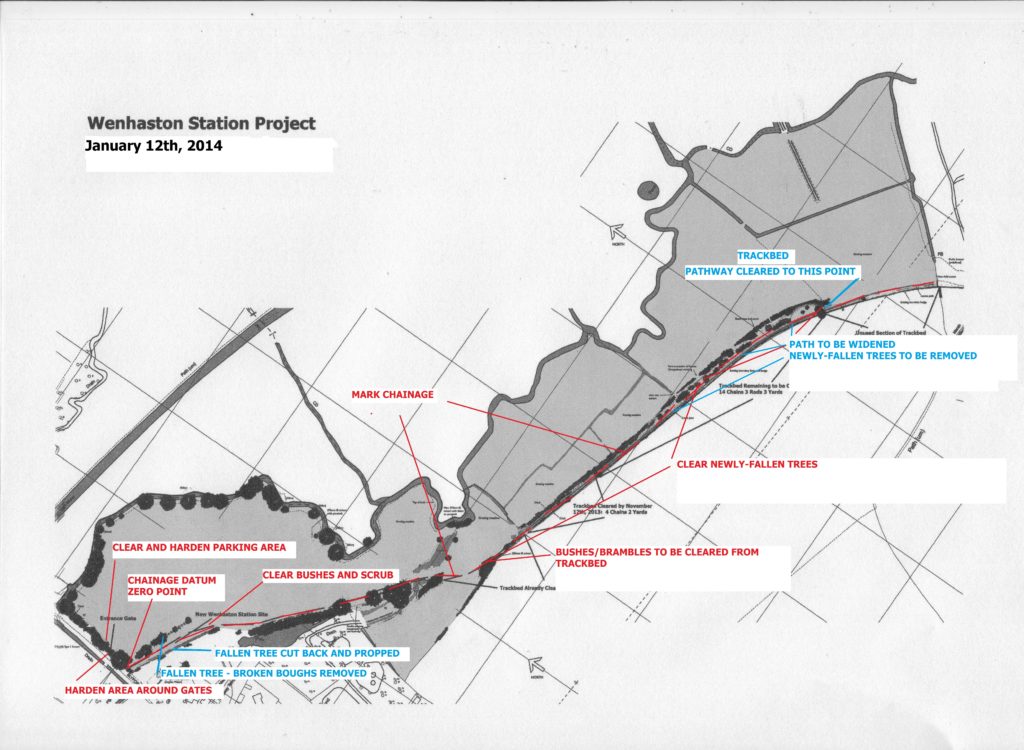
Another unscheduled work weekend at Wenhaston – because the weather was
so unseasonably warm and sunny (and anyway we don’t really need a
reason) – saw such a strong push along the trackbed eastwards that, at
the end of Sunday January 12th, the (initial) railway path broke through
to the daylight at the end of 20 chains of woodland.
But – to take things in order – on Saturday morning we arrived at
Wenhaston to find that yet another storm had knocked down a valuable
tree on the southern boundary of the station site. This was a blow in
both senses, as we were relying on the existing line of trees to shield
the station from our neighbours, and to form a pleasant rural backdrop
to the platform.
However, as the tree (rooted in the mud of the original station boundary
ditch) was in the process of demolishing the boundary fence, and was
anyway approaching the ground as we watched, we decided that we would
have to remove the northward branches and crown to reduce the weight.
Southward branches were left, and the tree levered back to an
approximately upright position, being held in place, temporarily, by two
forked wooden supports. We hope that this treatment will allow the
broken roots to re-grow, and the tree to regenerate. If this works,
it’ll have been a much better option than felling, and one much more in
keeping with our conservation aims.
Another and much larger tree had been blown down over the station site
from the north, by the 2013 storms. This we have started to tackle,
cutting back broken boughs to solid timber: we hope that this, also,
will be able to regenerate from the base of its trunk – the few
remaining upright boughs will be left in place to encourage this, and to
balance the tree.
But the big news is that we have reached the end of the wood. The last
few chains were rather easier than the earlier parts – though some
pretty considerable tangles of dead elm, ivy and brambles still created
formidable barriers. Some very large trees (sadly, not all already dead)
have been brought down by the recent storms all along the wood, and
these remain to be cleared.
The possible cutting I described in a previous blog turned out to be
only a longitudinal pit – probably one from which the SR mined sand and
gravel for the trackbed. This now acts as an admirable soakaway, so that
the trackbed itself is invariably dry, even after very heavy rain.
Today (perhaps because we were tired enough to stop, frequently, and
look around) we were struck by the quality of some of the best
stand-alone trees along this stretch – though the grand-daddy of them
all is still the patriarch oak at our Blyford Lane entrance. A very
large and very symmetrical oak towards the west end of the wood
dominates the trackbed there – it is growing, unfortunately, very close
to the designed track route, but we are pretty sure that a gentle
diversion of the track to the south would allow us to avoid the
destruction of this fine specimen.
There are another two younger oaks further to the west, one very
well-established, and one younger, which are growing about where the
southward rail would have been: here, a gentle northward diversion can
avoid unnecessary felling. An extremely fine ash at around the two
thirds point is luckily well off the line, and forms the centre of our
established picnic and rest area.
It may seem, to some, bizarre to be designing a railway rebuild which
“goes around” trees – but that’s the point of narrow gauge (as can
famously be seen on the Welshpool and Llanfair) – and it’s very much the
point of the Trust’s plans to be as light-footed on the landscape as
possible.
